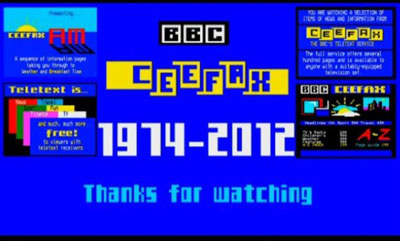First You Ceefax, Then You Don’t
Published on October 25th, 2012 in: Retrovirus, Science and Technology |By Emily Carney

Back in the halcyon days of broadcast television in the UK, a BBC teletext service called Ceefax (which stood for “See Facts”) was devised in an effort to provide viewers with the most current, continuously updated information possible, encompassing news, financial information, weather, and sports. It debuted in 1974.
Ceefax was actually the first teletext system used in the world. The system was originally limited to thirty “pages” of information and had a wonderfully eight-bit, low-tech (at least to viewers in 2012) vibe. It resembled being trapped in a Radio Shack Tandy computer. Occasionally viewers even were able to enjoy some cheesy, TRS-80-style “print @ line…” graphics in weather maps, among other things. It was pretty cool for its time. Eventually the BBC put on some smooth-as-silk easy listening tunes to go with the pages.
The service also provided challenges to its sub-editors, who condensed the day’s information into four-paragraph-long pages. Any editor can tell you this: Sometimes shrinking tons of information into a preset number of words and lines takes forever and a day. Ceefax made it look effortless. And before the advent of WiFi and digital TV, it remained a relevant news source.
While I don’t live in the UK, I remember the service from when I stayed in the UK years ago. It was more reliable than dial-up Internet—one could receive information well before the modem did its work. It was like the World Wide Web before the concept was commercially available and popular.
Well, as the cliché goes—all good things must come to an end. Ceefax ceased to exist on October 23 after 38 years of service, as the digital switchover was completed in Northern Ireland. The end of Ceefax marks the end of an era. We had some systems similar to this on public television in Florida, providing news and local events, but nothing ever had the awesomely low-fi template or up-to-date information provided by Ceefax.
A journalist named Matthew Engel wrote a piece called “Ceefax: A Love Letter,” which underscored the UK’s sadness at seeing the service leave televisions in a funny and touching way. It’s also in lovely, of-its-time obsolete 1970s graphics.
For those hankering to see some old pages from Ceefax in its heyday, here’s a 1980 clip. For those who want to marinate in some low-tech tears, here’s another BBC article showing the final pages from Ceefax. The page signed off and disappeared into a tiny blue dot before fading into blackness. What an elegiac, appropriate end to one of the last television vestiges remaining from the 1970s.
Time limit is exhausted. Please reload the CAPTCHA.